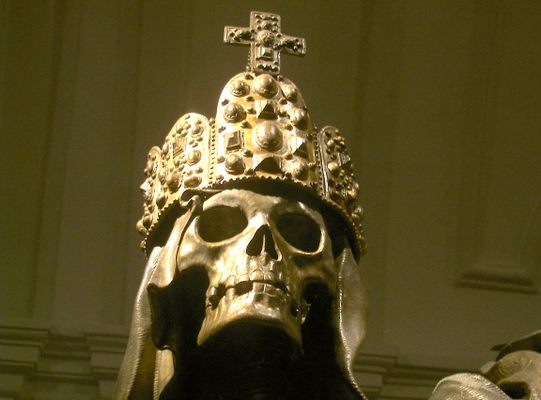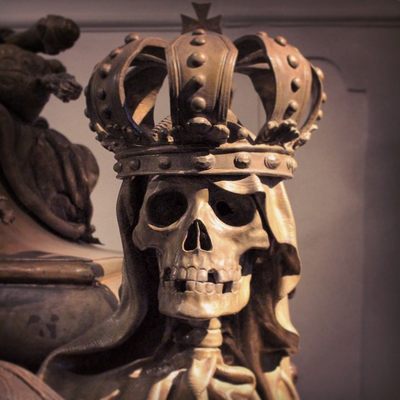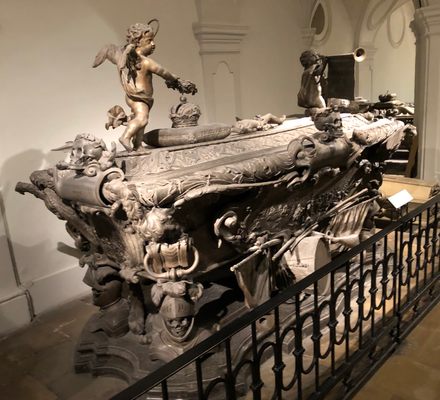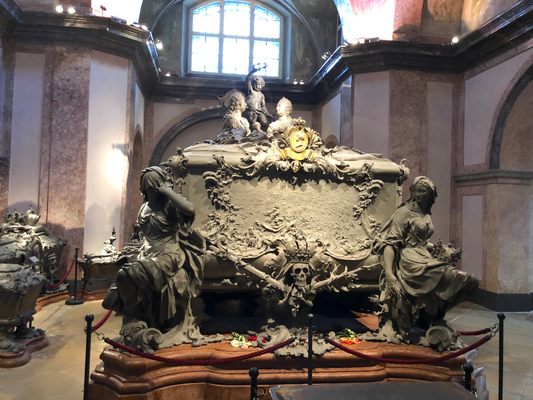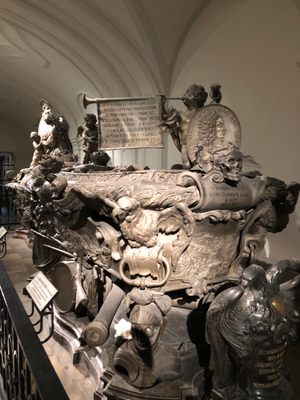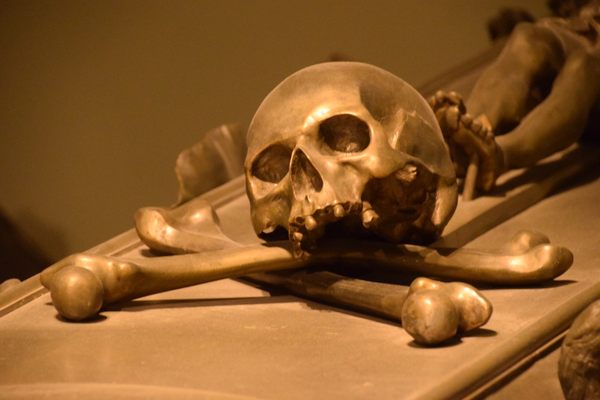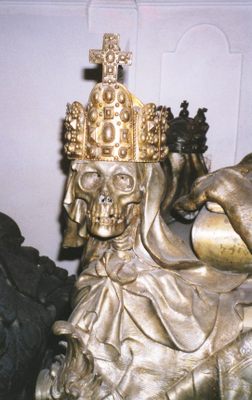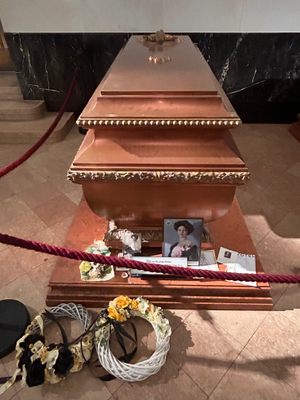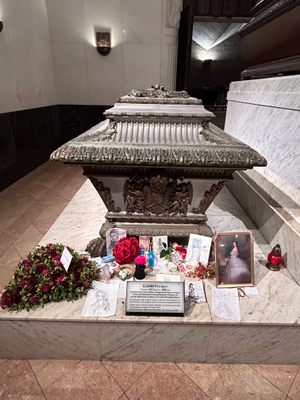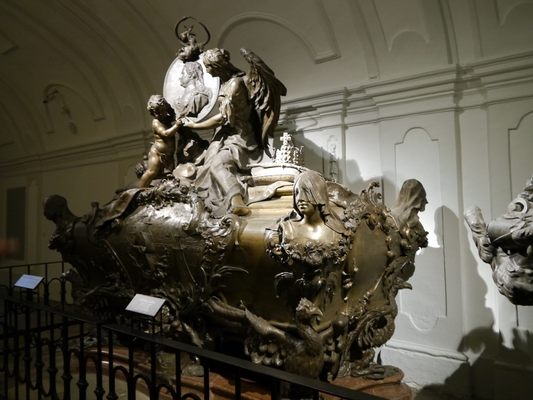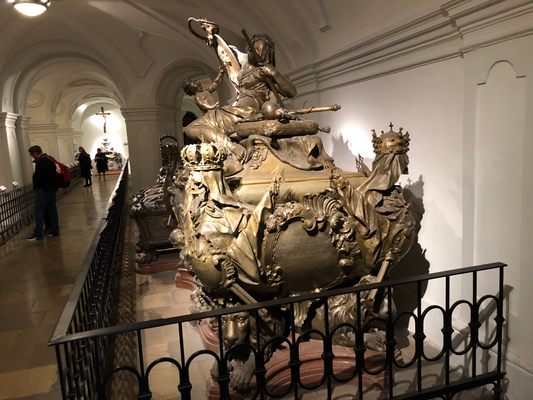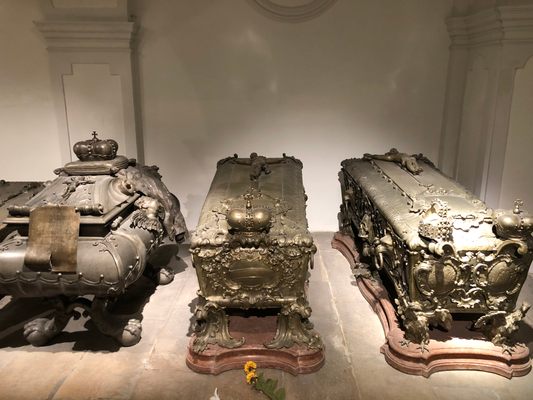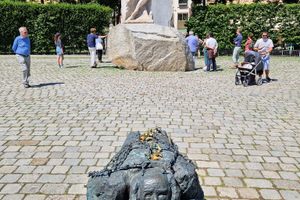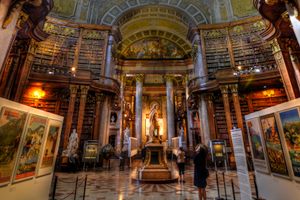About
Habsburg funerals were elaborate affairs. Death loomed large in the cultural life of the Viennese for centuries, celebrated in song, poetry, and artwork. Macabre memento-mori sculptures, designed to inspire piety, can be spotted throughout the city.
The death of an emperor or empress was a major event. As one of the major imperial royal dynasties of Europe, as well as the Holy Roman Emperors from 1438 to 1740, the Habsburgs ruled over much of Europe until their downfall in World War I. For many Habsburg monarchs their death meant not only the creation of an elaborate and beautiful sarcophagus for the Imperial Crypt, but also a silver urn to preserve their heart and reliquaries to contain their embalmed entrails. After the funeral, the parts of the deceased would part ways, to be interred in three separate holy crypts.
Twelve emperors, 18 empresses, and 113 other members of the Habsburg family are interred in the Imperial Crypt (Kaisergruft) in Vienna. The crypt, also known in German as the Kapuzinergruft ("Capuchins' Crypt”), holds 105 metal sarcophagi, the most elaborate of them designed by the royal sculptor Balthasar Ferdinand Moll. The Rococo double sarcophagus of Emperor Franz Stephan and his wife Empress Maria Theresa is considered his masterpiece. The royal couple lie on top of the tomb, surrounded by elaborate reliefs illustrating scenes from their lives.
The hearts of 54 members of the royal family are held in special urns in the Herzgruft, or "Heart Room,” located a few blocks away in St. George's Chapel of the Augustinerkirche, and the embalmed entrails of princes, queens and emperors are kept in the Ducal Crypt below the St. Stephen's Cathedral (Stephansdom).
The Imperial Crypt below the Capuchin Church and monastery was originally intended to hold only the remains of Empress Anna and Emperor Matthias, who died in 1618 and 1619. The crypt was expanded many times over the centuries to accommodate more royal remains: first in 1657 by Emperor Leopold I, again in 1754 by his daughter the Empress Maria Theresa, then again in 1908 by Emperor Franz Joseph. The buildings were restored more recently in the 1960s.
Emperor Franz Joseph's sarcophagus is the only one made from stone instead of metal. It is flanked by the coffins of his wife Elisabeth and son Rudolf. It was Rudolf's mysterious and tragic suicide (after murdering his 17-year-old mistress) in 1889 that began the downward trajectory of the Habsburg Empire. Because Rudolf left no male heir, the crown was passed from Franz Joseph to his nephew, Franz Ferdinand, whose assassination in 1914 tipped off World War I. Charles I, Franz Ferdinand's heir, became the last emperor of the Austro-Hungarian Empire.
Neither Franz Ferdinand nor Charles, however, is interred in the Imperial Crypt. Franz Ferdinand is interred with his wife Sophie in Artstetten Castle, Austria. Zita is interred at the crypt since 1989 (no. 146) . Charles is interred in the Church of Our Lady of Monte, in Madeira, and their hearts are held at the Loreto Chapel of Muri Abbey in Italy. Archduke Otto, the last Crown Prince of the Austro-Hungarian Empire, was interred in the Imperial Crypt following his death on July 4th, 2011. He is the last Habsburg to be interred there.
Related Tags
Know Before You Go
Located below the Capuchin Church on Neuer Markt square.
Community Contributors
Added By
Published
December 28, 2010
Sources
- The imperial crypt guide
- Find a Grave: Kapuzinergruft: http://www.findagrave.com/cgi-bin/fg.cgi?page=cr&CRid=639510
- Capuchin Crypt, Imperial Crypt: http://www.riemergasse.at/en/wien-sehenswertes/kapuzienergruft-kaisergruft/
- Nicholas Parsons: "Vienna: A Cultural History," Chapter 10: The Death Cult in Vienna
- Wikipedia: Imperial Crypt: http://en.wikipedia.org/wiki/Imperial_Crypt
- Bargain Travel Europe: The Emperor Tomb - Kaiser Crypt Vienna: http://www.bargaintraveleurope.com/09/Austria_Emperor_Tomb_Vienna.htm
- Wikipedia: Balthasar Ferdinand Moll: http://en.wikipedia.org/wiki/Balthasar_Ferdinand_Moll
